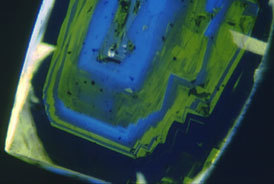Technology development program
background
The Key Centre's Research, Training and Industry Interaction programs require a high level of geochemical analytical technology, which is provided by the state-of-the-art facilities available to the Key Centre. Further development of both technology and innovative analytical and microanalytical approaches are required to meet the research aims, and the Centre is developing new analytical strategies for determining the chemical and isotopic compositions of geological materials (both solid and fluid). Special emphasis is being placed on the development of advanced in-situ microanalytical methods. These developments are transmitted to industry via open and collaborative research, through technology exchange visits and as an integral part of the training program.
- The GAU contains:
- a Cameca SX-50 electron microprobe
- a Perkin-Elmer ELAN 5100 ICPMS
- a custom-built laser microprobe attached to the ICPMS
- an automated Siemens XRF
- a LECO H2O-CO2 analyser.
- Newly installed clean labs and sampling facilities to provide the infrastructure required for ICPMS and isotopic analyses of small and/or low-level samples.
- Experimental petrology laboratories in GEMOC include piston-cylinder (9, 15 and 40 kb), hydrothermal apparatus, and controlled atmosphere furnaces; each node is well-equipped.
- The Centre for Isotope Studies provides access to state-of-the-art thermal ionisation mass spectrometers for analysis of Rb-Sr, Sm-Nd and U-Th-Pb systems, and extraction lines and gas-source mass-spectrometers for stable-isotope analysis of fluids and minerals.
- The ANU INAX facility includes:
- a new Spectro energy dispersive XRF
- an automated Philips XRF
- Australia's only non-commercial Neutron Activation Laboratory
- atomic absorption spectrophotometry
- sample preparation facilities for mass spectrometric analysis
- access to a Cameca Camebax microprobe, ICPMS and thermal ionisation mass spectrometer facilities through the Institute of Advanced Studies.
the GEMOC Facility for Integrated Microanalysis (FIM)
GEMOC is developing a unique, world-class geochemical facility, based on in-situ imaging and microanalysis of trace elements and isotopic ratios in minerals and rocks. The Facility for Integrated Microanalysis will consist of four different analytical instruments; all will be linked by a single sample positioning and referencing system to combine spot analysis with images of spatial variations in composition ("micro-GIS").
The Facility will provide:
- The capability to image both major- and trace-element distribution in a sample, as an interpretive tool and the basis for higher precision spot analysis of trace element concentrations and isotopic ratios.
- Co-registration of images and spot data from different instruments, and use of digitized images to locate spots with a precision of better than 5 microns (micro-GIS).
- Analytical capability for most elements of the periodic table at ppm to ppb levels.
- In-situ isotopic-ratio measurement for a range of elements, at the precision required for geologically useful results.
The Facility will consist of:
 |
Micro-GIS system: A key aspect of the Facility is the co-registration of images and point analyses collected on all instruments. All data for a sample, from any of the instruments or from a bench microscope, are in the same coordinate system and can be overlaid in the computer to enhance interpretation. Images from one instrument can be read into the computer of another instrument and used to guide the analysis. Major-element maps from EMP, or trace-element maps from the nuclear microprobe, may be compared directly with images from eg petrographic or cathodoluminescence microscopes, BSE or SEM. |
Electron Microprobe, for imaging and point analysis of major and minor elements.
Scanning Nuclear Microprobe, for imaging and point analysis of trace elements at ppm levels.
Laser-ablation ICPMS Microprobe, for point analysis of a wide range of trace elements at ppb levels.
Multi-collector Sector ICPMS with laser microprobe, for in-situ analysis of isotopic ratios.
Current status:
Electron microprobe (EMP): The existing GEMOC EMP is a CAMECA SX50, installed in 1993; it routinely produces high-precision analyses of major and minor elements with a spatial resolution of one micron, as well as high-quality images of major-element (>0.1 wt%) distribution over areas up to 45 x 45 mm, by stage-scanning with five fixed wavelength-dispersive spectrometers. The EMP is being upgraded with an energy-dispersive X-ray detector to allow rapid and simultaneous mapping of all major elements.
Scanning nuclear microprobe (SNMP): This instrument is being built as a separate beam line on the HIAF particle accelerator at CSIRO, North Ryde. It will incorporate several complementary types of detector, a new high-resolution probe-forming system and an innovative optical system, and is designed to provide both images of trace-element distribution and spot analyses, with a lateral resolution of 1-3 microns. The capabilities will include:
(a) micro-PIXE : Proton Induced X-ray Emission (PIXE) using focused MeV proton beams provides non-destructive, simultaneous, quantitative microanalysis of trace elements with concentrations down to the ppm level.
(b) micro-PIGE : Proton Induced Gamma-ray Emission (PIGE) spectra can be collected simultaneously with PIXE analysis. The gamma-rays provide non-destructive analysis of light elements (e.g. Li, Be, B, F, Na) with detection limits of 10-200 ppm. PIGE also provides analysis of anions (H, C, O, S, Cl) which are difficult to analyse by ICPMS and EMP.
(c) CCM: In Channelling-Contrast Microscopy (CCM), MeV energy beams of alpha particles or protons are channelled into the crystal planes and axes of minerals. CCM can be used to yield images of lattice location information or to distinguish elements sited in inclusions from those in solid solution. This capability can be applied to the trace levels detected using ion backscattering, micro-PIXE and micro-PIGE.
(d) Quantitative True Elemental Imaging: The SNMP will provide trace-element imaging of areas up to 2.5 mm across; these images will be digitised so that any pixel or larger area can be retrieved, and analysed separately for its element concentrations. The Dynamic Analysis (DA) method developed at the CSIRO enables live-time assembly of true elemental images that discriminate against pile-up, inter-element overlap, background and detector artefacts such as escape peaks and tailing.
Laser Ablation ICPMS microprobe (LAM): The existing GEMOC LAM was installed in December 1994. It uses a Perkin-Elmer ELAN 5100 ICPMS, attached to a UV laser ablation microprobe built for GEMOC by Memorial University, Newfoundland. The instrument now routinely provides quantitative analyses of >30 elements at sub-ppm levels in minerals, glasses and metals. Spatial resolution varies with the application, but typically is on the order of 30-40 microns. The LAM is being fitted with a computer-driven sample stage to provide co-registration of X-Y coordinates with the other instruments.
Multi-collector LA-ICPMS microprobe (MC-LAM-ICPMS): GEMOC will acquire a fully-equipped MC-ICPMS as an integral part of the Facility. This instrument will combine a laser ablation microsampler, an Ar-plasma ionisation source, and a multi-collector magnetic-sector mass spectrometer, to provide high-precision in-situ analysis of isotope ratios in geological materials. The MC-ICPMS also can be used in solution mode, to supplement the capabilities of the conventional mass spectrometers at the Centre for Isotope Studies.
Planned applications include:
Laser Analysis (in-situ point analysis)
- U-Pb dating of zircon, monazite, apatite
- Lu-Hf dating of zircon; Hf isotope studies for crustal generation
- Sm-Nd dating, Nd isotopes in apatites, REE minerals
- Sr isotope analysis of carbonates, apatites
- Pb isotopes in sulfides
- Stable isotope ratios of Zn, Cu and other cations in hydrothermal systems
Solution Analysis
- Re-Os -- mapping of mantle depletion ages in whole rocks and chromites
- Lu-Hf -- crustal genesis, mantle metasomatism; Lu-Hf dating of garnet peridotites, eclogites, granulites
- Sm-Nd, U-Pb faster and simpler than TIMS; simplified chemistry, no time-dependent mass-fractionation
progress in 1996
1.Facility for Integrated Microanalysis
- A proposal for $1100K was submitted to the ARC Research Infrastructure and Equipment Funding Program, for funds to upgrade the EMP and LAM instruments, construct the SNMP and purchase the MC-ICPMS. Matching funds were obtained from Macquarie University, ANU, CSIRO-EM and industry. The proposal was awarded $500K. Despite the shortfall, we will be able to build most of the FIM, over a longer time span.
- The EDS upgrade for the EMP, and the computerized stage for the LAM, have been purchased.
- Design parameters for the SNMP were finalized and construction of the microprobe lens has begun in collaboration with the Dept. of Physics, Univ. of Melbourne.
- Visits to three factories and two laboratories have been carried out to evaluate MC-ICPMS instruments; a decision is expected in May and installation should take place late in 1997. This will be the first such instrument in the Southern Hemisphere.
2. New energy dispersive XRF (Spectro) unit acquired at ANU
3. A new ELAN 6000 ICPMS was installed (without capital investment from GEMOC) in the Macquarie laboratory by Perkin Elmer Australia, to be used for collaborative development work and for training of PE clients. The Macquarie laboratory will host the Fourth Australasian Symposium on Applied ICP-Mass Spectrometry in May 1997.
4. Development work on the laser-ablation ICPMS resulted in techniques for fully quantitative analysis of >30 elements in glasses and common silicate, oxide and sulfide minerals. The analytical protocol greatly reduces interelement fractionation, a requirement for reproducible analysis. We demonstrated excellent agreement between LAM-ICPMS data and those from the proton microprobe, solution ICPMS and NAA (Norman et al., 1996; appendix 3). The laboratory produced large volumes of data for three PhD thesis projects (Belousova, Yao, Xu), several projects carried out by international visitors, and in-house research projects. It also routinely provides data for projects related to mineral exploration (diamonds, base metals, Au), as a consulting service to the industry.
support sources
GEMOC and ANU industry support includes:
- direct funding of research programs
- "in kind" funding including field support (Australia and overseas)
- access to proprietary databases, sample collections, digital datasets
- collaborative research programs (eg APA Industry and full PhD program funding)
- assistance in the implementation of GIS technology in postgraduate programs
industry interaction, technology transfer and commercialisation program
The Key Centre relies on a vigorous interaction with the mineral exploration industry at both the research and the teaching/training levels. The research results of the Centre's work are transferred to the industry and to the scientific community by:
- Interaction through collaborative industry-supported Honours, MSc and PhD projects
- Short courses relevant to the industry and government sector users, designed to communicate and transfer new technologies, new techniques and new knowledge in the discipline areas covered by the Key Centre
- AMIRA- sponsored collaborative research projects
- One-on-one research collaborations and shorter-term consultancies on industry problems involving national and international partners
- Provision of high quality geochemical analysis and interpretations to industry and government organisations, extending our industry interface
- Expansion of the DIATREEM (Macquarie University) and INAX (ANU) consultancies, which employ and disseminate the technological developments carried out by the Centre
Progress in 1996
- The mineral exploration industry currently is funding three new postgraduate student projects. In each case, the company involved also provides invaluable in-kind support, and has been closely involved in formulating the research project.
- AMIRA project negotiated (Blevin and Chappell) on granite-related mineralisation.
- A new collaborative research project was started within the Lithosphere Mapping strand, with Kennecott Canada Inc. (see Research Program, above). A representative of KCI visited the laboratory for exchange of information, and KCI hosted a visit to their Vancouver headquarters by a Macquarie postgraduate student, to study Canadian diamonds.
- A collaborative project on the Siberian lithosphere was negotiated with Almazy Rossii Sakha, and a representative visited GEMOC for one week to plan the project and to participate in the analytical work.
- A representative from Anglo American Research Laboratories spent one week for technology transfer in the ICPMS laboratory at Macquarie, learning our approach to analysis and exchanging information about AARL's experience with infra-red lasers in ICPMS analysis.
- DIATREEM began providing LAM-ICPMS analyses of garnets and chromites to the diamond-exploration industry on a routine basis, in cooperation with CSIRO-EM.
- Short courses (described above) on Geochemical Analysis and Thermal Processes in the Earth attracted industry support and participation.

 GEMOC ARC National Key Centre
GEMOC ARC National Key Centre